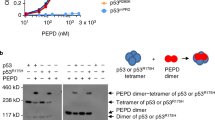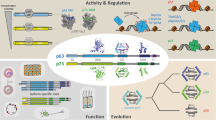Abstract
p53 is a sequence-specific transcriptional activator with a number of known target genes which contain p53-responsive elements. Mutations in p53 have been identified within its sequence-specific DNA binding domain in more than half of all human tumors, although a subset of tumor-derived p53 mutants have retained the ability to bind DNA and activate transcription under certain conditions. In order to broaden our understanding of this transactivating ability, we examined the efficacy by which p53 mutants bind to and activate reporters in an Saccharomyces cerevisiae-based assay. Analysis of 19 human tumor-derived p53 mutants, spanning the DNA binding domain of p53 and including the `hot-spot' class, revealed a broad array of transcriptional transactivation abilities at 24°C, 30°C and 37°C, despite the fact that each mutant had originally been identified as being inactive for transactivation in yeast against a single p53-responsive RGC site-containing reporter. One class of mutants (P177L, R267W, C277Y and R283H) retained wild-type or near wild-type activity that is binding site-selective, even at physiological temperature (37°C). Another class of mutants (V143A, M160I/A161T, H193R, Y220C and I254F), all positioned for maintaining the β-scaffold of p53, also retained selective activity, but preferentially at sub-physiological temperatures (24° and 30°C). Strikingly, however, in contrast to the other tumor derived mutants, all of the previously identified `hot-spot' mutants were completely inactive with all sites tested. Moreover, a double mutant, L22E/W23S, located within the activation region and previously shown to be transcriptionally inactive in fibroblasts, retained wild-type or near wild-type binding site-selective activity in yeast. Finally, we found that transcriptional activity in vivo does not necessarily correlate with DNA binding in vitro.
This is a preview of subscription content, access via your institution
Access options
Subscribe to this journal
Receive 50 print issues and online access
$259.00 per year
only $5.18 per issue
Buy this article
- Purchase on Springer Link
- Instant access to full article PDF
Prices may be subject to local taxes which are calculated during checkout
Similar content being viewed by others
Author information
Authors and Affiliations
Rights and permissions
About this article
Cite this article
Como, C., Prives, C. Human tumor-derived p53 proteins exhibit binding site selectivity and temperature sensitivity for transactivation in a yeast-based assay. Oncogene 16, 2527–2539 (1998). https://doi.org/10.1038/sj.onc.1202041
Received:
Revised:
Accepted:
Published:
Issue Date:
DOI: https://doi.org/10.1038/sj.onc.1202041
Keywords
This article is cited by
-
Translating p53-based therapies for cancer into the clinic
Nature Reviews Cancer (2024)
-
A role for bioinorganic chemistry in the reactivation of mutant p53 in cancer
JBIC Journal of Biological Inorganic Chemistry (2022)
-
Rare TP53 variant associated with Li-Fraumeni syndrome exhibits variable penetrance in a Saudi family
npj Genomic Medicine (2018)
-
Gα12 gep oncogene deregulation of p53-responsive microRNAs promotes epithelial–mesenchymal transition of hepatocellular carcinoma
Oncogene (2015)
-
High Frequency of Temperature-Sensitive Mutants of p53 in Glioblastoma
Pathology & Oncology Research (2013)



